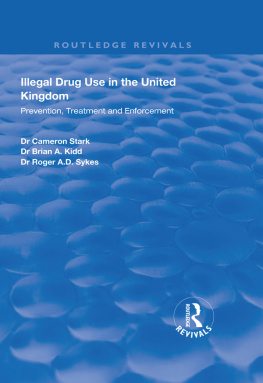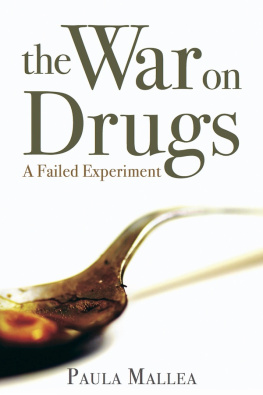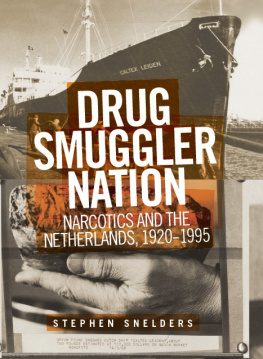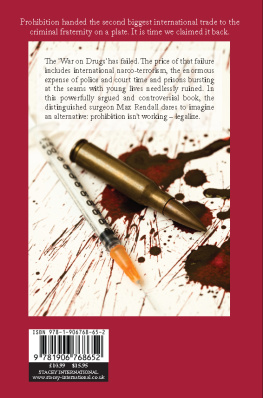The Geography of Illegal Drugs
The Geography of Illegal Drugs
George F. Rengert
To a loving family whose daddy wanted to stop work early
rather than late all those nights. Especially Roger and Graham
and their mommy who read aloud Lorna Doone when I was not
there and Little Women when I was.
First published 1996 by Westview Press
Published 2018 by Routledge
711 Third Avenue, New York, NY 10017, USA
2 Park Square, Milton Park, Abingdon, Oxon OX14 4RN
Routledge is an imprint of the Taylor & Francis Group, an informa business
Copyright 1996 Taylor & Francis
All rights reserved. No part of this book may be reprinted or reproduced or utilised in any form or by any electronic, mechanical, or other means, now known or hereafter invented, including photocopying and recording, or in any information storage or retrieval system, without permission in writing from the publishers.
Notice:
Product or corporate names may be trademarks or registered trademarks, and are used only for identification and explanation without intent to infringe.
Rengert, George F.
The geography of illegal drugs / George F. Rengert.
p. cm.
Includes bibliographical references and index.
ISBN 0-8133-8986-0 (hc) ISBN 0-8133-6650-X (pbk)
1. Drug trafficUnited States. I. Title.
HV5825.R44 1996
363.4'5'0973dc20
96-12154
CIP
ISBN 13: 978-0-8133-6650-0 (pbk)
We have a problem in the United States: it is called an illegal drug problem. We have another problem as well: we like to blame the first problem on someone else and want to use force to solve it. As a result, we call our efforts to solve our illegal drug problem a "war on drugs." War means using force on an outside enemy-but do we have an outside enemy? What if the enemy is us? Then, in declaring a war on drugs, we have declared a war on ourselves.
Some people claim that we would not have an illegal drug problem if citizens of foreign countries would stop producing these illegal drugs and smuggling them into our nation. We have gone into some of these countries and declared war on the growers of drugs that are illegal in the United States. Herbicides have been sprayed on fields producing marijuana and the coca plant in Mexico, Colombia, Peru, and Bolivia. The most widely publicized of these efforts was the spraying of paraquat on marijuana fields in Mexico. When marijuana sprayed with paraquat is smoked, it can produce permanent lung damage. Have we declared war on ourselves?
Turkey, in cooperation with the United States government, succeeded in curtailing its opium production. The result was a rise in the price of opium in the shortrun and an increase in production in the neighboring countries of Iran and Afghanistan. These countries are now profiting greatly in the opium trade. The government of Iran is an avowed enemy of the United States. Have we declared war on ourselves?
Finally, we hear community leaders declare that there would not be a drug problem if outsiders would not bring drugs into their communities. Again, it is someone else's fault; supposedly we should solve the drug problem by attacking the strangers who are the mid-to high-level distributors bringing drugs into our neighborhoods and cities. In the meantime, most people are killed or victimized by people within their own neighborhoods. Crime prevents investment in inner-city neighborhoods by threatening property values, endangering lives, and increasing the costs of doing business in the city. In our nation's capital, an average of one youth a day has been shot or stabed in their own neighborhood, an unprecedented level of juvenile assaults that police atributed to turf batties among local drug dealers. Have we declared war on ourselves by ignoring our local communities?
In the following chapters, I examine the distribution of illegal drugs in our country and our society to illustrate the similarities and differences between illegal drugs and legal commodities. I examine the many ramifications of government and citizens' attempts to interrupt the smooth flow of illegal drugs into and within our communities. The conclusion is an appeal for addressing the problem of illegal drugs at its source-not the supply source in someone else's country or neighborhood, but the demand source within our own communities. If we are to win a war on drugs, the engagement must be within our own communities. We must create environments where drugs are not available and drug abusers are given incentives to change their habits.
George F. Rengert
I owe a debt of gratitude to Chris Salvatico of Terragraphix Inc. who prepared the maps and diagrams in this book. He also did the layout. His professionalism and understanding of my mistakes and false starts made the publication of this book easier. Karen Fienberg provided excellent editorial work on the manuscript, often on short notice. Jill Rothenberg of Westview Press saw the book through from start to finish and kept me on the right track.
Several people have commented on various drafts of this book. The most helpful and insightful comments came from Kris Rengert who improved the entire book with many detailed comments and criticisms. Obviously, any mistakes are my fault because sometimes I didn't listen to him.
I have used drafts of this book in several classes at Temple University. I thank the students in my Urban Crime Patterns classes who provided comments and experiences which improved the book. I also acknowledge with gratitude my colleagues in the Criminal Justice Department at Temple University who provide a stimulating and exciting atmosphere within which to work.
The research reported in was conducted under grant # 88-IJ-CX-0013 from the National Institute of Justice. Points of view and opinions expressed in this book are my own and neither reflect nor represent the official policies or positions of the National Institute of Justice or the U.S. Government.
G. F. R.
The production and distribution of illegal drugs has much in common with legal sales enterprises. Producers of raw materials are often located in foreign countries, manufacturers convert the raw material into consumable products, and distributors transport these products to the final consumers. For those who believe that these enterprises should remain illegal, the task is to disrupt the smooth functioning of these operations in any legal manner possible.
Although legal, many people view as less than ethical some of the efforts by the United States government which focus on foreign producers. For example, we have pressured Bolivia, Peru, and Colombia to eradicate the production of the coca plant while encouraging them at the same time to import tobacco produced in the United States. Bourne (1989) argues that more Colombians die from the effects of U.S. tobacco products than the number of Americans who die from Colombian cocaine. Evidence shows that more Europeans die from the use of United States tobacco products than from the use of drugs imported from other foreign countries (Polman, 1993). Even within our own borders, the American Cancer Society claims, "More Americans die each year from illness related to smoking than from heroin, crack, homicide, car accidents, fires and AIDS combined" (Will, 1992, p. Al). "For every person who dies from cocaine poisoning, 15 people die from the direct effects of alcohol and 60 from tobacco-related illnesses, according to the Public Health Service. No deaths from marijuana have ever been reported" (Baum, 1993, p. 70). Therefore the inconsistency of the United States government's policies has caused many people to doubt the sincerity of our "war on drugs." Newcomb and Bentler sum up this inconsistency:









